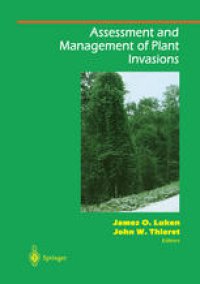
Ebook: Assessment and Management of Plant Invasions
- Tags: Agriculture, Forestry, Plant Sciences
- Series: Springer Series on Environmental Management
- Year: 1997
- Publisher: Springer-Verlag New York
- Edition: 1
- Language: English
- pdf
Biological invasion of native plant communities is a high-priority problem in the field of environmental management. Resource managers, biologists, and all those involved in plant communities must consider ecological interactions when assessing both the effects of plant invasion and the long-term effects of management. Sections of the book cover human perceptions of invading plants, assessment of ecological interactions, direct management, and regulation and advocacy. It also includes an appendix with descriptive data for many of the worst weeds.
Biological invasion of native plant communities is a high-priority problem in the field of environmental management. Resource managers, biologists, and all those involved in plant communities must consider ecological interactions when assessing both the effects of plant invasion and the long-term effects of management. Sections of the book cover human perceptions of invading plants, assessment of ecological interactions, direct management, and regulation and advocacy. It also includes an appendix with descriptive data for many of the worst weeds.
Biological invasion of native plant communities is a high-priority problem in the field of environmental management. Resource managers, biologists, and all those involved in plant communities must consider ecological interactions when assessing both the effects of plant invasion and the long-term effects of management. Sections of the book cover human perceptions of invading plants, assessment of ecological interactions, direct management, and regulation and advocacy. It also includes an appendix with descriptive data for many of the worst weeds.
Content:
Front Matter....Pages i-xiv
Introduction....Pages 1-3
Front Matter....Pages 5-5
Defining Indigenous Species: An Introduction....Pages 7-17
Defining Weeds of Natural Areas....Pages 18-25
Potential Valuable Ecological Functions of Nonindigenous Plants....Pages 26-34
Front Matter....Pages 35-35
Documenting Natural and Human-Caused Plant Invasions Using Paleoecological Methods....Pages 37-55
Community Response to Plant Invasion....Pages 56-68
Impacts of Invasive Plants on Community and Ecosystem Properties....Pages 69-86
Animal-Mediated Dispersal and Disturbance: Driving Forces Behind Alien Plant Naturalization....Pages 87-94
Outlook for Plant Invasions: Interactions with Other Agents of Global Change....Pages 95-103
Experimental Design for Plant Removal and Restoration....Pages 104-116
Response of a Forest Understory Community to Experimental Removal of an Invasive Nonindigenous Plant (Alliaria petiolata Brassicaceae)....Pages 117-130
Front Matter....Pages 131-131
Management of Plant Invasions: Implicating Ecological Succession....Pages 133-144
Methods for Management of Nonindigenous Aquatic Plants....Pages 145-171
Biological Control of Weeds in the United States and Canada....Pages 172-194
Prioritizing Invasive Plants and Planning for Management....Pages 195-212
Front Matter....Pages 213-213
Prevention of Invasive Plant Introductions on National and Local Levels....Pages 215-227
Exotic Pest Plant Councils: Cooperating to Assess and Control Invasive Nonindigenous Plant Species....Pages 228-243
Team Arundo: Interagency Cooperation to Control Giant Cane (Arundo donax)....Pages 244-248
A Multiagency Containment Program for Miconia(Miconia calvescens)an Invasive Tree in Hawaiian Rain Forests....Pages 249-254
Back Matter....Pages 255-324
Biological invasion of native plant communities is a high-priority problem in the field of environmental management. Resource managers, biologists, and all those involved in plant communities must consider ecological interactions when assessing both the effects of plant invasion and the long-term effects of management. Sections of the book cover human perceptions of invading plants, assessment of ecological interactions, direct management, and regulation and advocacy. It also includes an appendix with descriptive data for many of the worst weeds.
Content:
Front Matter....Pages i-xiv
Introduction....Pages 1-3
Front Matter....Pages 5-5
Defining Indigenous Species: An Introduction....Pages 7-17
Defining Weeds of Natural Areas....Pages 18-25
Potential Valuable Ecological Functions of Nonindigenous Plants....Pages 26-34
Front Matter....Pages 35-35
Documenting Natural and Human-Caused Plant Invasions Using Paleoecological Methods....Pages 37-55
Community Response to Plant Invasion....Pages 56-68
Impacts of Invasive Plants on Community and Ecosystem Properties....Pages 69-86
Animal-Mediated Dispersal and Disturbance: Driving Forces Behind Alien Plant Naturalization....Pages 87-94
Outlook for Plant Invasions: Interactions with Other Agents of Global Change....Pages 95-103
Experimental Design for Plant Removal and Restoration....Pages 104-116
Response of a Forest Understory Community to Experimental Removal of an Invasive Nonindigenous Plant (Alliaria petiolata Brassicaceae)....Pages 117-130
Front Matter....Pages 131-131
Management of Plant Invasions: Implicating Ecological Succession....Pages 133-144
Methods for Management of Nonindigenous Aquatic Plants....Pages 145-171
Biological Control of Weeds in the United States and Canada....Pages 172-194
Prioritizing Invasive Plants and Planning for Management....Pages 195-212
Front Matter....Pages 213-213
Prevention of Invasive Plant Introductions on National and Local Levels....Pages 215-227
Exotic Pest Plant Councils: Cooperating to Assess and Control Invasive Nonindigenous Plant Species....Pages 228-243
Team Arundo: Interagency Cooperation to Control Giant Cane (Arundo donax)....Pages 244-248
A Multiagency Containment Program for Miconia(Miconia calvescens)an Invasive Tree in Hawaiian Rain Forests....Pages 249-254
Back Matter....Pages 255-324
....
Download the book Assessment and Management of Plant Invasions for free or read online
Continue reading on any device:

Last viewed books
Related books
{related-news}
Comments (0)